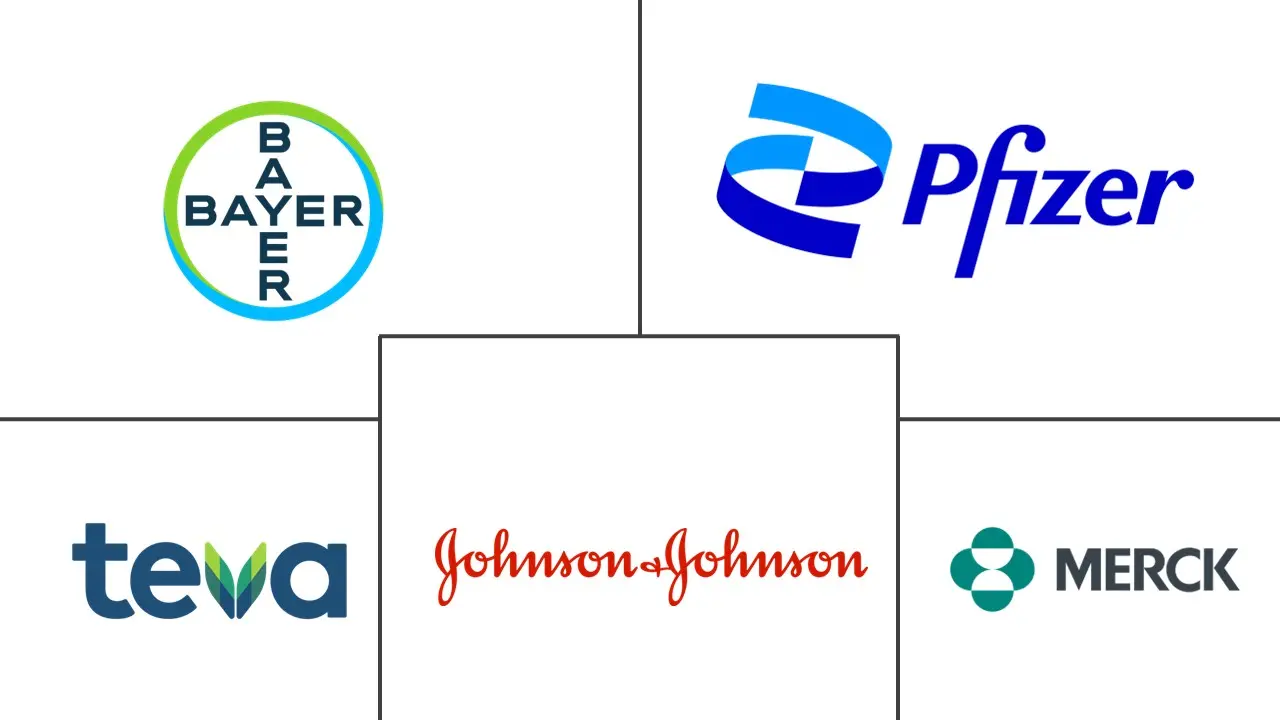Hormonal Contraceptives Market Size and Share
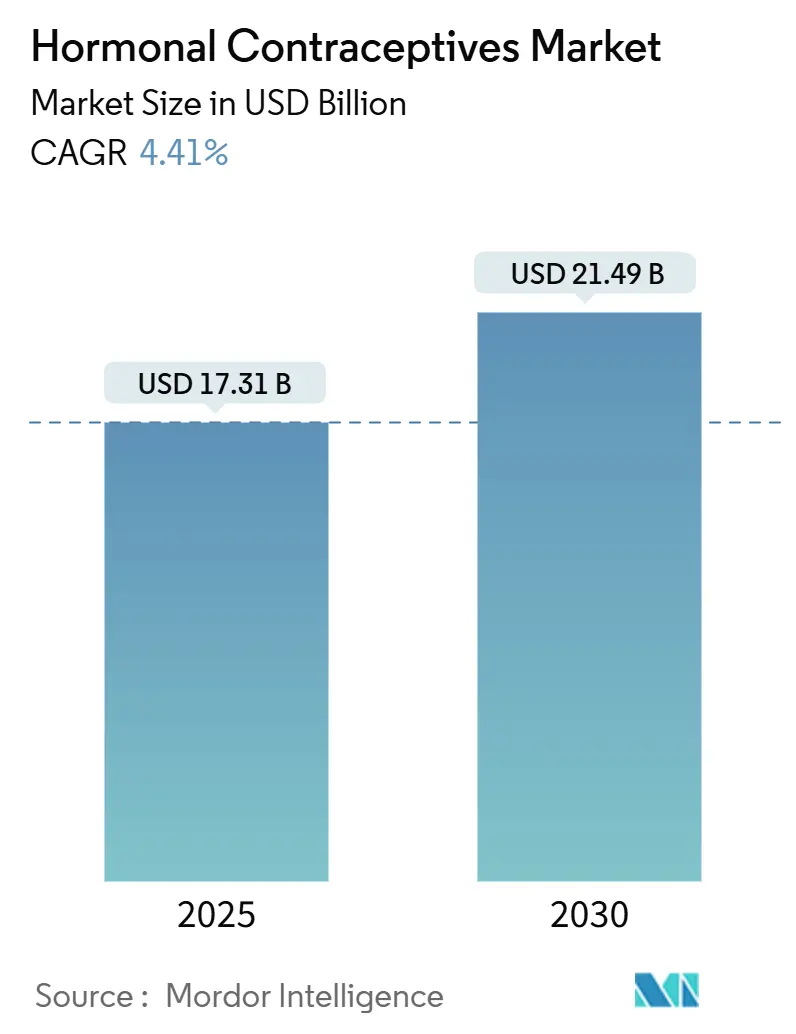
Hormonal Contraceptives Market Analysis by Mordor Intelligence
The hormonal contraceptive market is valued at USD 17.31 billion in 2025 and is forecast to reach USD 21.49 billion by 2030, advancing at a 4.41% CAGR. Expansion is propelled by telehealth-enabled prescription services, the first U.S. OTC daily pill approval, and rising demand for long-acting methods. Online pharmacies already outpace every other channel, expanding at an 8.65% CAGR, while hospital pharmacies still hold the largest 40.1% revenue share. North America commands 41.17% of global revenue thanks to favorable reimbursement frameworks, whereas Asia’s 5.10% CAGR underscores significant headroom as urban consumers pivot to long-acting reversible contraceptives (LARCs). Competitive intensity remains moderate; incumbents such as Bayer AG defend share through lifecycle extensions, while newer entrants differentiate on eco-friendly technologies. Throughout 2025, sustainability, digital accessibility, and safety-driven reformulations remain the clearest opportunity lanes for the hormonal contraceptive market.
Key Report Takeaways
- By product category, oral contraceptives led with a 43.45% revenue share in 2024; hormonal implants are projected to expand at a 7.89% CAGR through 2030.
- By hormone type, combined formulations held 61.23% of the hormonal contraceptive market share in 2024, while progestin-only products are set to grow at a 6.65% CAGR through 2030.
- By usage duration, short-acting reversible contraceptives accounted for a 57.67% share of the hormonal contraceptive market size in 2024; LARCs are advancing at a 7.07% CAGR through 2030.
- By distribution channel, hospital pharmacies controlled 38.44% revenue in 2024, yet online pharmacies post the fastest 7.45% CAGR to 2030.
- By end user, household/at-home use represented 52.83% of 2024 revenue; community health centers are rising at a 6.03% CAGR through 2030.
- By age group, women aged 25-34 accounted for 42.45% revenue in 2024; demand among women above 44 years is increasing at a 4.88% CAGR.
- By geography, North America led with a 36.45% revenue share in 2024, while Asia Pacific is projected to grow at a 6.23% CAGR to 2030.
Global Hormonal Contraceptives Market Trends and Insights
Drivers Impact Analysis
| Driver | (~) % Impact on CAGR Forecast | Geographic Relevance | Impact Timeline |
|---|---|---|---|
| Advancements in Products | +1.2% | Global, with early adoption in North America & Europe | Medium term (2-4 years) |
| High Incidence of Unintended Pregnancies and Supportive Government Policies | +0.9% | Global, with significant impact in Asia & Africa | Long term (≥ 4 years) |
| Telehealth-Enabled Prescription Fulfillment | +0.8% | North America, Europe, Urban Asia | Short term (≤ 2 years) |
| Rising OTC Approval of Oral Contraceptive Pills | +0.7% | North America, with gradual expansion to Europe & Asia | Medium term (2-4 years) |
| Awareness for Family Planning and Delayed Pregnancy Trend | +0.6% | Global, with stronger impact in developing markets | Long term (≥ 4 years) |
| Shift Toward Eco-Friendly, Biodegradable Patch Materials | +0.3% | Europe, North America, Urban Asia | Long term (≥ 4 years) |
| Source: Mordor Intelligence | |||
Advancements in Products
Lower-dose formulations aimed at minimizing side effects are redefining product expectations. The drospirenone 3 mg/estetrol 14.2 mg pill—the first combination to feature a novel estrogen in six decades—shows negligible impact on coagulation while preserving cycle control. As brands refocus on active-ingredient profiles, they deliver a differentiated safety narrative attractive to risk-averse users.
High Incidence of Unintended Pregnancies and Supportive Government Policies
Roughly 40% of global pregnancies are unintended, driving public funding for family-planning programs. In the United States, 21 million women received publicly supported contraceptive services in 2025 at a cost of USD 2.1 billion; every dollar spent saves USD 4.26 in healthcare outlays. Federal rules mandating no-cost coverage of FDA-approved methods strengthen baseline demand.[1]U.S. Department of Health & Human Services, “Proposed Rule to Strengthen Access to Contraception,” hhs.gov
Telehealth-Enabled Prescription Fulfillment
A 2024 JAMA Network Open study found 30% higher continuation when contraceptive visits were virtual, especially benefiting rural and low-income users. Thailand’s telehealth implant follow-up program posted a 94% satisfaction rate, with most issues resolved online. Convenience accelerates uptake worldwide.
Rising OTC Approval of Oral Contraceptive Pills
The FDA’s clearance of Opill (norgestrel 0.075 mg) as an OTC pill in 2024 removed prescription hurdles and retails near USD 20 per month.[2]American College of Obstetricians and Gynecologists, “First Over-the-Counter Daily Contraceptive Pill Released,” ACOG Practice Advisory, acog.orgLabel-comprehension studies showed 94% of consumers could self-screen appropriately, setting the stage for broader OTC adoption.
Restraints Impact Analysis
| Restraint | (~) % Impact on CAGR Forecast | Geographic Relevance | Impact Timeline |
|---|---|---|---|
| Rising Social Media Backlash on Hormone-Related Side-Effects | -0.7% | Global, with highest impact in North America & Europe | Short term (≤ 2 years) |
| Supply Bottlenecks in Key APIs such as Levonorgestrel | -0.5% | Global, with cascading effects in emerging markets | Medium term (2-4 years) |
| Availability of Alternatives | -0.4% | Global, with stronger impact in developed markets | Medium term (2-4 years) |
| Price Caps on Essential Drugs Limiting Profit Pools | -0.3% | Emerging markets, particularly Asia & Latin America | Long term (≥ 4 years) |
| Source: Mordor Intelligence | |||
Rising Social Media Backlash on Hormone-Related Side-Effects
Nearly 1 in 5 contraceptive-related social posts discuss adverse events, amplifying discontinuation risk. Influencers with large followings can turn isolated incidents into global talking points within hours, prompting regulators to revisit safety language sooner than planned and compelling brands to invest more in real-time reputation monitoring.
Supply Bottlenecks in Key APIs such as Levonorgestrel
USP is drafting new monographs to stabilize sourcing while USAID still flags vulnerability despite an 89% on-time delivery rate for family-planning commodities. Any quality-audit failure or transport disruption can trigger multi-quarter stock-outs, forcing public programs to ration inventory or revert users to less preferred methods.
Segment Analysis
Product: Oral Contraceptives Lead Despite Innovation Elsewhere
Oral pills retained a 43.45% share in 2024, powered by decades of clinical familiarity. OTC status for Opill widens consumer reach and could lift the hormonal contraceptive market share for pills in 2025. Implants, though accounting for a smaller revenue base, grow quickest at 7.55% CAGR on superior compliance. Twirla, a low-dose estrogen patch for users with BMI < 30 kg/m², revitalizes interest in transdermal delivery.[3]FDA, “Twirla Label Information,” accessdata.fda.govHormonal IUDs such as Mirena now benefit from FDA-approved use up to eight years, deepening value propositions.
Second-generation vaginal rings, lower-dose injectables, and emergency pills maintain niche relevance by addressing diverse user needs. Collectively, these modalities reinforce method mix depth that sustains the hormonal contraceptive market.
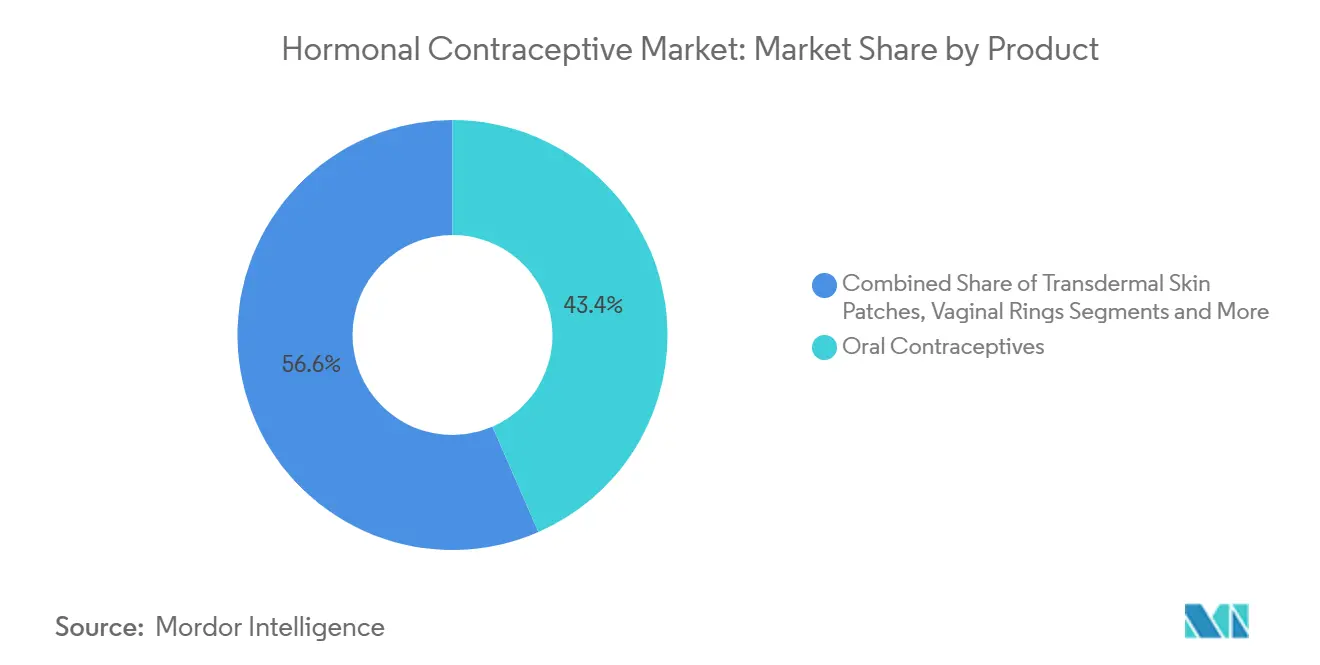
Note: Segment shares of all individual segments available upon report purchase
Hormone: Combined Formulations Dominate Despite Progestin-Only Growth
Combined estrogen-progestin products represented 61.23% of 2024 revenue. However, cardiovascular risk dialogues encourage pivot toward progestin-only choices, expected to outpace at 6.65% CAGR. The drospirenone/estetrol pill shows the combined category can still evolve with minimal coagulation effect. Meanwhile, the OTC approval of a progestin-only pill repositions that sub-segment as the safer everyday option, underpinning incremental hormonal contraceptive market size gains.
Usage Duration: LARCs Gaining on Traditional SARCs Dominance
Short-acting methods held 57.67% revenue in 2024, yet LARCs climb steadily. Education level, urban residence, and wealth correlate with LARC uptake, which is projected at 7.07% CAGR. In 2023, LARCs delivered 64% of USAID-reported Couple-Years of Protection, validating field-level traction. Once regulatory clearance arrives for a five-year Nexplanon extension, the hormonal contraceptive market size for implants should widen further.
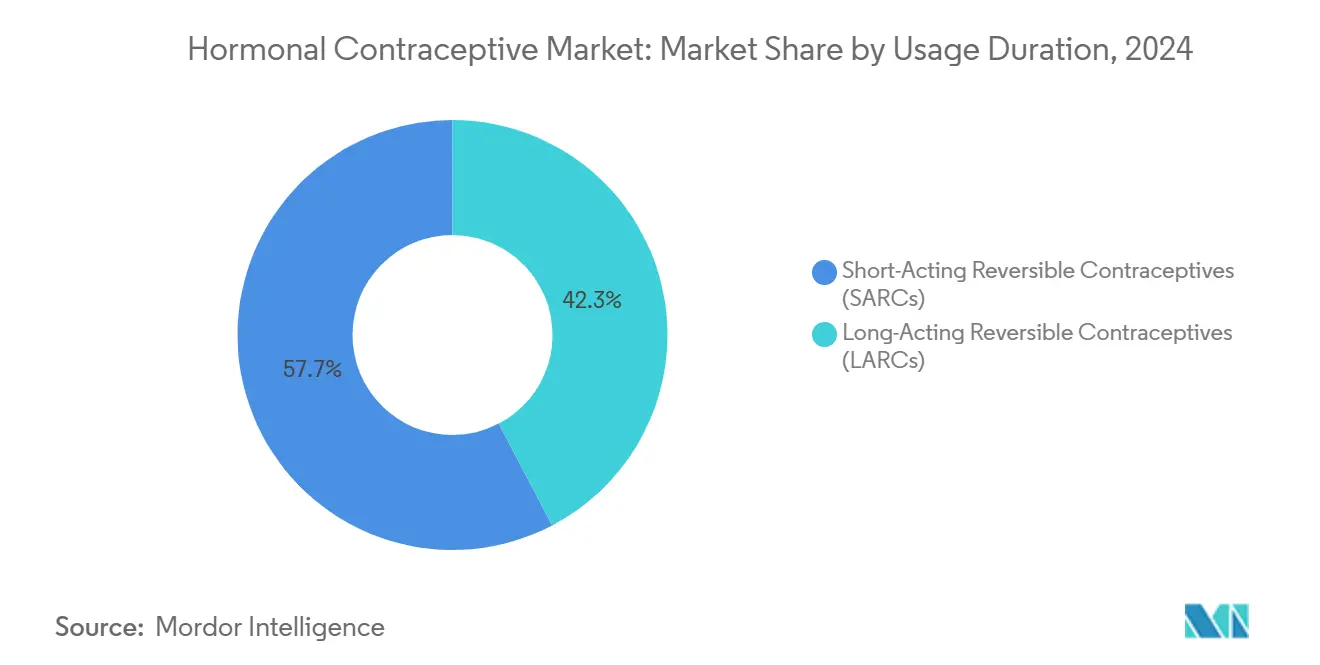
Note: Segment shares of all individual segments available upon report purchase
Distribution Channel: Digital Disruption Reshaping Traditional Networks
Hospital pharmacies remain the top channel at 38.44%, but e-commerce’s 7.45% CAGR is highest. GoodRx’s dedicated Opill storefront exemplifies digital convenience. Expanded pharmacist prescribing authority in 29 U.S. states bolsters retail pharmacy relevance. NGOs and Title X clinics safeguard low-income access, reinforcing equity within the hormonal contraceptive market.
End User: At-Home Use Dominates as Self-Administration Expands
Household use reached 52.83% of 2024 sales, buoyed by discreet mail-delivery services. Hospitals and gynecology clinics still perform critical IUD and implant procedures. Community health centers, growing 6.03% CAGR, remain a bridge for underserved groups. School-based clinics improve adolescent access and lower teenage pregnancy, diversifying demand profiles inside the hormonal contraceptive market.[4]Centers for Disease Control and Prevention, “Reproductive Health in School Health Centers,” cdc.gov
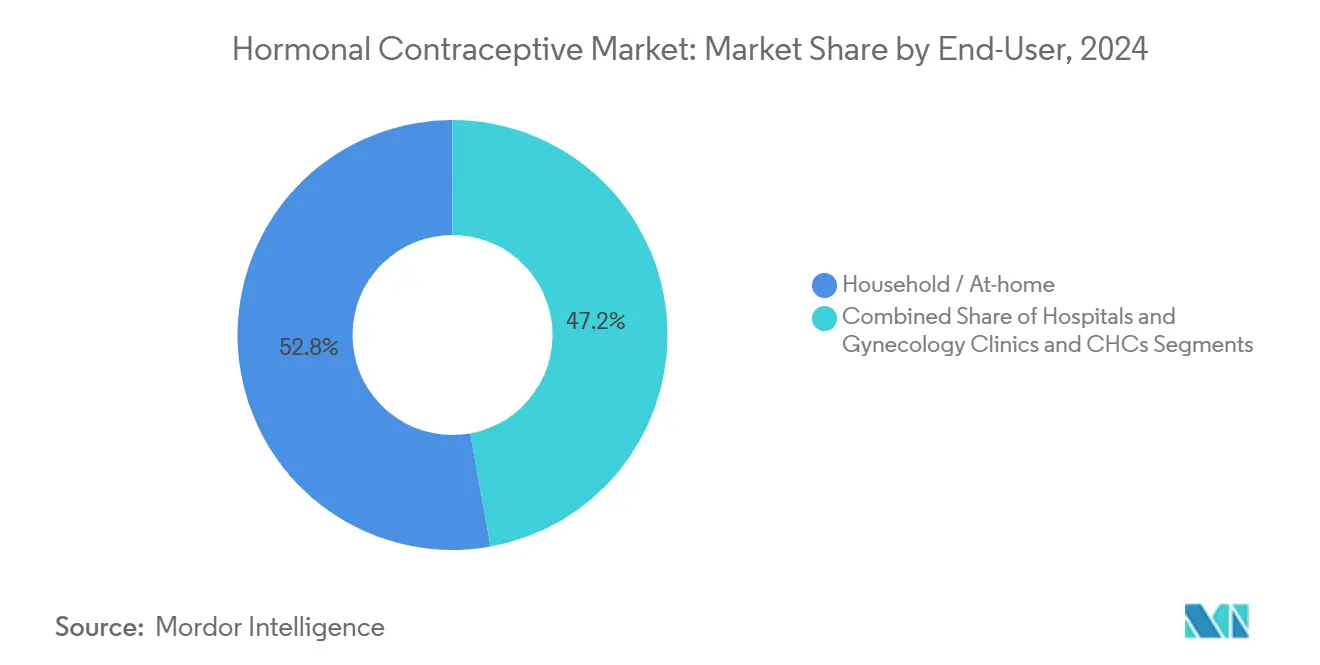
Note: Segment shares of all individual segments available upon report purchase
Age Group: Mid-Career Women Lead While Post-Reproductive Segment Grows Fastest
Women aged 25-34 contributed 42.45% in 2024, reflecting peak fertility considerations. Teens face confidentiality barriers, but school clinics mitigate gaps. Above-44 users now grow quickest at 4.88% CAGR as perimenopausal women seek cycle regulation and non-contraceptive benefits. Education doubles the likelihood of use in emerging markets, signaling continued expansion room for the hormonal contraceptive market.
Geography Analysis
North America held 36.45% of 2024 revenue. The FDA’s OTC pill decision and insurance mandates bolster usage.[2]American College of Obstetricians and Gynecologists, “First Over-the-Counter Daily Contraceptive Pill Released,” ACOG Practice Advisory, acog.org Political uncertainty around Title X funding could temper clinic reach, yet digital fulfillment offsets potential setbacks.
Asia-Pacific, posting a 6.23% CAGR, captures latent demand in urban India, Indonesia, and China. Contraceptive disparities between metropolitan and rural counties highlight infrastructure needs; targeted public programs aim to close gaps, enlarging the hormonal contraceptive market size across the region.
Europe maintains stable uptake under universal coverage, yet stricter antitrust scrutiny challenges pricing flexibility. Latin America benefits from public initiatives, but affordability issues and cultural norms restrain rapid acceleration. The Middle East and Africa display uneven penetration; South Africa and Nigeria emerge as focus markets, aided by donor-supported supply chains. Oceania contributes steady volumes but small absolute value due to the population scale.
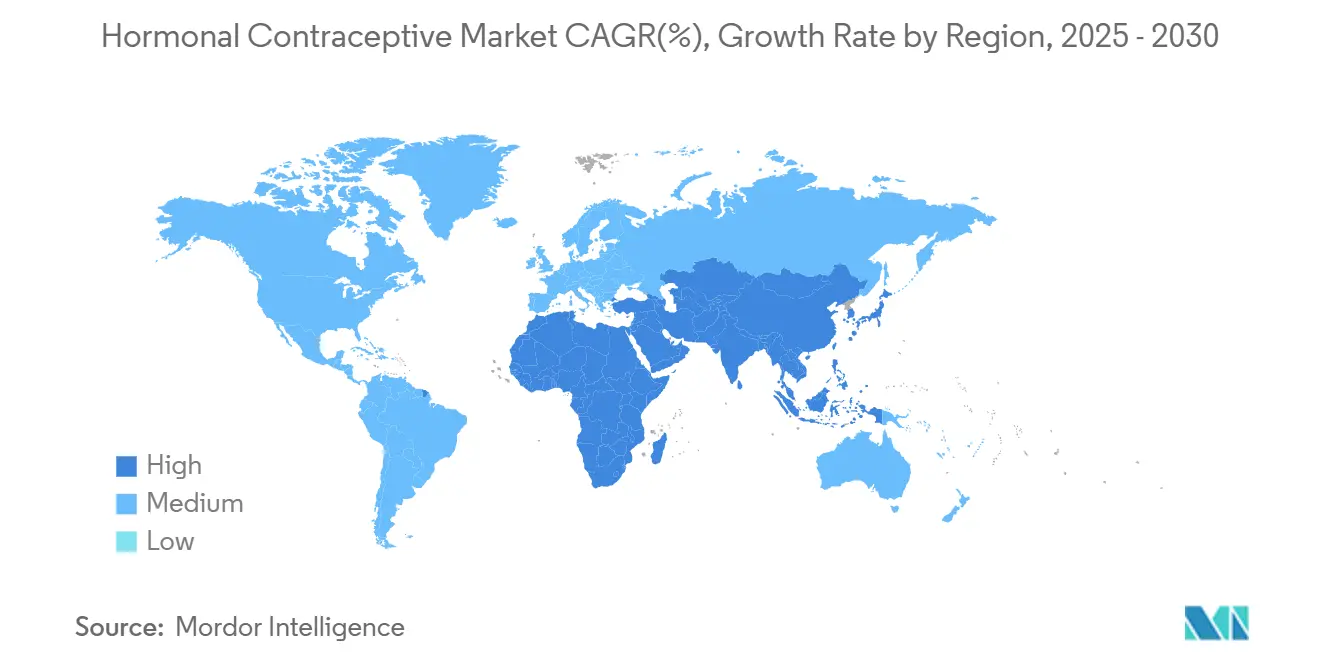
Competitive Landscape
The hormonal contraceptive market features moderate fragmentation: leading multinationals coexist with agile specialists. Bayer AG prolongs Mirena’s lifecycle through an eight-year indication, while Organon’s women’s health unit earned USD 1.8 billion in 2024 and seeks a five-year extension for Nexplanon. Daré Bioscience develops Ovaprene, a hormone-free monthly ring now in Phase 3, answering unmet demand for non-hormonal options.
Digital disruptors weaken incumbents’ pharmacy leverage. GoodRx’s e-commerce pivot illustrates platform power. Sustainability opens whitespace: biodegradable patches and microneedles furnish new brand narratives. API suppliers and telehealth providers steadily consolidate, but no single actor holds outsized control, leaving headroom for differentiated innovation within the hormonal contraceptive market.
Hormonal Contraceptives Industry Leaders
-
Merck & Co., Inc.
-
Pfizer Inc.
-
Bayer AG
-
Teva Pharmaceutical Industries Ltd
-
Johnson & Johnson Services, Inc
- *Disclaimer: Major Players sorted in no particular order
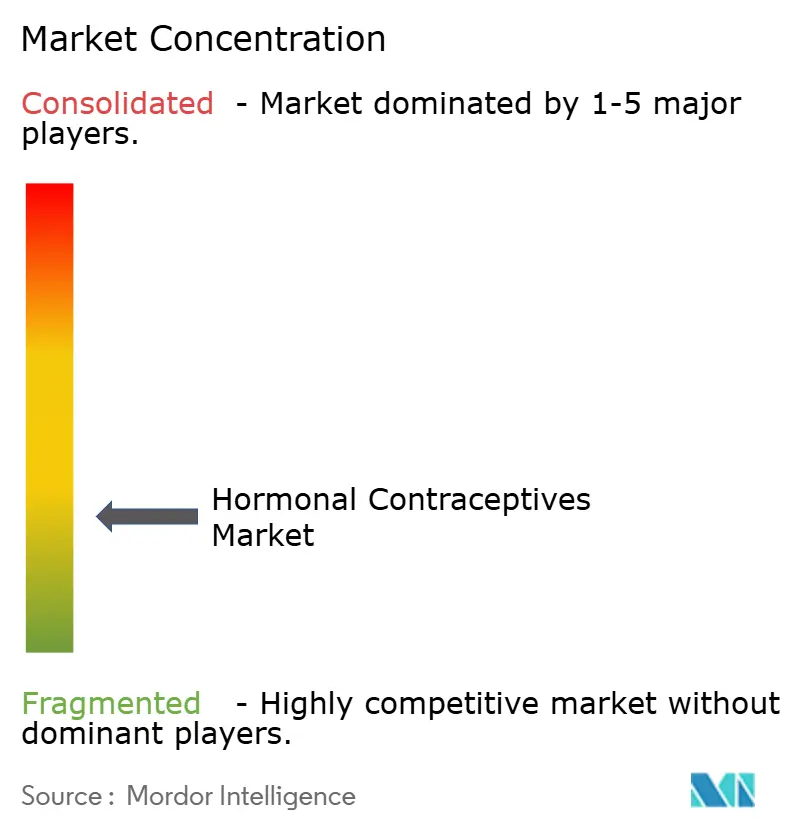


Recent Industry Developments
- March 2025: Daré Bioscience confirmed 15 active Phase 3 sites for Ovaprene, expecting full enrollment by mid-2025
- March 2025: Evofem Biosciences signed a license and supply deal with Windtree Therapeutics, cutting Phexxi manufacturing costs by up to 60%, broadening affordability.
- December 2024: Organon filed with the FDA to extend Nexplanon use to five years, fortifying its implant franchise.
- October 2024: GoodRx opened a dedicated Opill e-commerce portal, reaching women lacking local healthcare services.
Research Methodology Framework and Report Scope
Market Definitions and Key Coverage
Our study defines the hormonal contraceptives market as prescription or over-the-counter pharmaceutical preparations and implantable or intrauterine devices that release synthetic estrogen, progestin, or their combination to suppress ovulation, thicken cervical mucus, or thin the endometrium, thereby preventing pregnancy across reproductive-age women. Coverage spans pills, injectables, patches, rings, hormonal IUDs, implants, and emergency pills sold through physical or digital pharmacy channels in more than 25 countries.
Scope Exclusion: We deliberately leave out barrier methods, fertility-tracking apps, and permanent sterilization procedures.
Segmentation Overview
- By Product
- Oral Contraceptives
- Transdermal Skin Patches
- Hormonal Injectables
- Vaginal Rings
- Intrauterine Devices (Hormonal)
- Hormonal Implants
- Emergency Pills
- Others
- By Hormone
- Combined (Estrogen + Progestin)
- Progestin-Only
- By Usage Duration
- Short-Acting Reversible Contraceptives (SARCs)
- Long-Acting Reversible Contraceptives (LARCs)
- By Distribution Channel
- Hospital Pharmacies
- Retail Pharmacies
- Online Pharmacies & E-commerce
- NGOs and Public Health Clinics
- By End User
- Hospitals and Gynecology Clinics
- Household / At-home Use
- Community Health Centers
- By Age Group
- 15- 24 Years
- 25 -34 Years
- 35- 44 Years
- Above 44 Years
- Geography
- North America
- United States
- Canada
- Mexico
- Europe
- Germany
- United Kingdom
- France
- Italy
- Spain
- Rest of Europe
- Asia-Pacific
- China
- Japan
- India
- Australia
- South Korea
- Rest of Asia-Pacific
- Middle East and Africa
- GCC
- South Africa
- Rest of Middle East and Africa
- South America
- Brazil
- Argentina
- Rest of South America
- North America
Detailed Research Methodology and Data Validation
Primary Research
During interviews, we validate uptake assumptions with obstetricians, reproductive-health NGOs, wholesale distributors, and payers across North America, Europe, Asia-Pacific, and Africa. User surveys in four key economies clarify brand switching, course adherence, and out-of-pocket trends that filings rarely reveal.
Desk Research
Mordor analysts first map the universe of hormonal products with publicly available information drawn from regulators such as the US FDA, European Medicines Agency, and India's CDSCO. We rely on demographic and health surveys issued by UN DESA, WHO, and national statistics bodies, plus trade intelligence from UN Comtrade and clinical evidence indexed on PubMed. Company 10-Ks, investor decks, and quarterly calls retrieved through D&B Hoovers and Dow Jones Factiva add pricing and pipeline clues, while procurement portals and tender databases anchor real-world transaction values. This list is illustrative; many additional open sources inform the dataset.
A second pass compiles shipment and formulation-approval data from bodies such as IFPMA and regional gynecology societies, and we pull patent analytics via Questel, ensuring regulatory filings and market availability align before we lock the numbers.
Market-Sizing & Forecasting
We build a top-down demand pool from child-bearing-age female populations, modern-method prevalence, and average annual consumption per user. We then corroborate totals with sampled ASP × volume roll-ups for high-penetration brands. Variables such as adolescent fertility rate, OTC pill launches, reimbursement coverage, and long-acting reversible contraceptive adoption feed a multivariate regression layered on scenario analysis. Where bottom-up checks diverge beyond eight percent, we adjust transparently.
Data Validation & Update Cycle
Analysts run variance tests against historical sales and macro indicators, reconciling anomalies before sign-off. Reports refresh annually, with interim updates if regulatory or macro shocks require.
Why Mordor's Hormonal Contraceptives Baseline Commands Reliability
Published estimates often diverge because firms pick different product baskets, price points, base years, and refresh cadences.
Our disciplined scope, dual-track modeling, and yearly update rhythm help decision-makers compare apples with apples.
Benchmark comparison
| Market Size | Anonymized source | Primary gap driver |
|---|---|---|
| USD 17.31 B (2025) | Mordor Intelligence | |
| USD 19.90 B (2024) | Global Consultancy A | Bundles non-hormonal devices and applies uniform global ASP, inflating value |
| USD 16.75 B (2024) | Industry Association B | Counts prescription sales only and omits online-pharmacy revenue |
| USD 14.28 B (2024) | Trade Journal C | Uses older hospital-only sample and minimal emerging-market coverage |
The comparison shows that once scope mismatches and pricing shortcuts are stripped away, Mordor's balanced, transparent baseline remains the most dependable starting point for strategic planning.


Key Questions Answered in the Report
1. What is the hormonal contraceptive market size in 2025 and how fast is it growing?
The market is worth USD 17.31 billion in 2025 and is projected to expand at a 4.41% CAGR to USD 21.49 billion by 2030.
2. Which product segment is expanding the fastest?
Hormonal implants post the quickest 7.89% CAGR through 2030, reflecting user preference for long-lasting efficacy.
3. How does OTC availability influence access to birth control?
The FDA’s OTC approval of Opill removes prescription barriers and lowers entry costs, broadening reach for women lacking routine healthcare access
4. Why are LARCs gaining popularity over short-acting options?
LARCs offer superior real-world effectiveness and lower long-term costs, driving a 7.07% CAGR that outpaces short-acting methods.
5. What role does telehealth play in contraceptive distribution?
Virtual consultations boost continuation rates by 30% and improve rural access, fueling rapid growth in online pharmacy channels
6. Which region offers the strongest future growth opportunity?
Asia Pacific is projected to record a 6.23% CAGR, supported by urbanization, government initiatives, and growing awareness of modern contraception.
Page last updated on:
